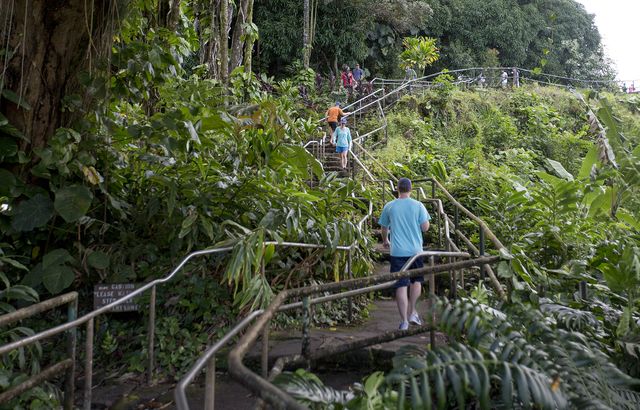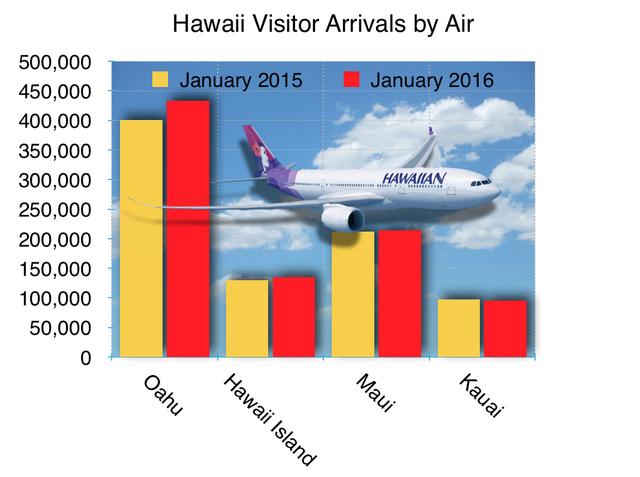Recent tourism statistics suggest Hawaii Island’s dengue fever outbreak hasn’t had the overall negative impacts some feared. ADVERTISING Recent tourism statistics suggest Hawaii Island’s dengue fever outbreak hasn’t had the overall negative impacts some feared. The month of January saw
Recent tourism statistics suggest Hawaii Island’s dengue fever outbreak hasn’t had the overall negative impacts some feared.
The month of January saw a year-over-year increase of visitor arrivals of 3.8 percent for the Big Island, with tourist spending climbing 7.7 percent, according to preliminary data from the Hawaii Tourism Authority.
Those are encouraging numbers, Big Island Visitors Bureau Executive Director Ross Birch said, especially when one considers the chilling effect a disease outbreak can have on tourism. Hawaii Island has been wrestling with dengue fever since an outbreak of the mosquito-borne virus began in September.
“For me, it was a very positive month,” Birch said Thursday morning. “Not just for us as an island, but by comparison with the other islands. It doesn’t seem like dengue has been much of an effect.”
Statewide, Hawaii had a record start to 2016, with 720,997 visitor arrivals, showing growth from January 2015 of 6.2 percent.
Oahu had the biggest jump in air arrivals for tourists of 8.2 percent, with Hawaii Island taking the second spot in the state. However, growth in per person spending per day was highest on the Big Isle, with people spending an average of $173.50 a day, a 6.6 percent increase over January 2015.
Hawaii Island also put up the biggest increase in total visitor expenditures, with tourists leaving behind $216.3 million in January, an increase of 7.7 percent over last year.
Birch said he had anticipated the Big Island could see stagnant visitor numbers or even a drop in visits of between 5 and 10 percent in a “worst-case outbreak scenario.”
So any increase at all in visitor arrivals, let alone the second highest increase in the state, shows that the other islands didn’t draw many visitors from the Big Island due to the outbreak, he said.
That’s not to say that some businesses haven’t suffered, he added. Property owners near some of the hardest hit spots in West Hawaii like Hookena and Milolii have reported big losses to their visitor rentals business. But the numbers appear to show that rather than visiting other islands, visitors chose to visit other parts of Hawaii Island, Birch said.
“Where I thought they would have picked up some of the displacement we had from dengue, we appeared to hold our ground,” he said. “(Tourists) came here, but they may not have stayed on some of the properties near where they’ve had the biggest problems (with dengue).”
Surprisingly, many of the outdoor activities that could bring people into contact with dengue-infected mosquitoes showed big jumps in business in January.
“I’ve kept in close contact with most of the hiking companies, volcano tours and zip line companies,” Birch said.
“They basically had a record fall and month of January. Some of the places with the most mosquito-ridden activities saw no dip, and in fact were seeing increases. … Those activities did very well.”
Outreach efforts by the visitors bureau and industry appeared to have spread the word that tourists don’t have to avoid visiting the Big Island, Birch said, as long as they follow the advice of the “Fight the Bite” campaign, which recommends people wear insect repellent, long sleeves and pants in areas where mosquitoes are prevalent, avoid areas with heavy mosquito infestations, and avoid outdoor activities around dawn and dusk, when mosquitoes are most active.
Email Colin M. Stewart at cstewart@hawaiitribune-herald.com.




